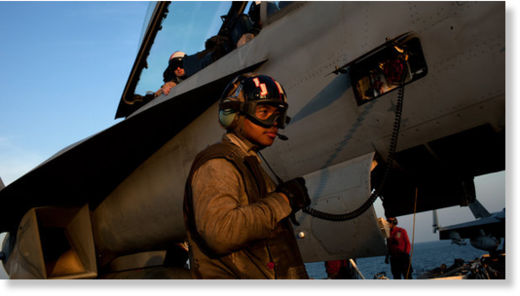
Steaming in international waters over the horizon from the Iranian fleet, the John C. Stennis spent the day and the early hours of the night launching and recovering aircraft for its latest mission - supporting ground troops in Afghanistan. All visible indications were that the carrier's crew was keeping to its scheduled work, regardless of any political or diplomatic fallout from Iran's warnings.
"It is business as usual here," said Rear Adm. Craig S. Faller, commander of the carrier strike group, as he watched a large-screen radar image showing the nearby sea and sky cluttered with commercial traffic.
The screen also showed Navy jets flying back and forth in a narrow air corridor to Afghanistan, known as "the boulevard."
The day's sorties, not the words of Iran, commanded attention here throughout the afternoon and evening. Returning pilots discussed low-elevation passes to suppress Taliban fighters near an Italian patrol in Farah Province and to help British troops under fire in Helmand Province. The subject of Iran barely came up in the briefings and meetings.
Later, after another cycle of returning aircraft came roaring back onto the deck, one by one, the ship sounded taps at 10 p.m. The crew maintained a normal watch schedule. So began an ordinary night for a warship at sea, no matter the saber-rattling of the previous day.
On Tuesday, the chief of Iran's military, Maj. Gen. Ataollah Salehi, was quoted by a semiofficial Iranian news agency as telling "the American warship that passed through the Strait of Hormuz and went to the Gulf of Oman not to return to the Persian Gulf."
The remark was an unmistakable reference to this ship. After providing air support to American troops during the last weeks of the Iraq war, the John C. Stennis steamed through the strait about a week ago, leaving the Persian Gulf to take up station in the nearby North Arabian Sea.
General Salehi, who commands Iran's navy and air force as well as its army, added, darkly, "The Islamic Republic of Iran will not repeat its warning."
But the scenes on the ship throughout Wednesday, along with the behavior of the Iranian Navy, suggested that the threats were mainly for popular consumption, not as a marker of imminent confrontation.
On the John C. Stennis the radar images extended to the Iranian coastline. Clusters of Iranian warships, which have been conducting a large-scale Iranian naval exercise, were marked in red on the screen. But the American and Iranian ships were widely separated. They did not challenge one another. Each minded its own business, which for the Americans was a busy day pushing jets north toward the Afghan war.
Late in the afternoon, Admiral Faller noted that the only disruption his crew had felt came in the form of worried e-mails to officers and sailors from friends and family in the United States who had been following coverage of the general's threat.
Investors were worried, too, and they bid up oil prices. But the Iranian ships did not escalate the tensions or menace the carrier and the warships accompanying it in any way, the ship's crew said.
"They don't go out of their way to come and check us out, and we don't go out of our way to divert from our primary missions," the admiral said.
Out on the sea, General Salehi's warning felt, if not carefully calibrated, then at least carefully timed.
Anyone with an Internet connection could have seen from the ship's Facebook page and its commanders' ample statements to the news media in recent months that the carrier's high-seas deployment, which follows a roughly predictable pattern, was winding down. Any casual follower of ship movements could have deduced that the John C. Stennis was probably not scheduled to return to the Persian Gulf anyhow.
As they planned the next day's missions even as the last aircraft returned to the ship, Admiral Faller and his officers and crew had no comment about the general's threat.
They referred to what had been said already in Washington: that United States ships sailed lawfully in international waters, and that they would not tolerate any effort by Iran or any other nation to close the Strait of Hormuz.
As for that, they said, everything was normal in the strait that day. "We get all the news," Admiral Faller said. "We get CNN. We get Fox. We have access to the Internet, and we are voracious consumers of information. We saw those statements. But we also watch the sea. And we haven't seen anything unprofessional at sea."



Reader Comments
to our Newsletter